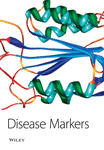Caveolin-1 Expression in Thyroid Neoplasia Spectrum: Comparison of Two Commercial Antibodies
Abstract
We evaluated caveolin-1 expression in the human thyroid neoplasia spectrum with the aim of examining differences in expression as detected by two anti-caveolin-1 antibodies, and secondly, to investigate the association of caveolin-1 expression levels with aggressive papillary thyroid carcinoma (PTC). Immunohistochemical staining using sc894 or AV09019 antibodies revealed that caveolin-1 was generally overexpressed in the PTC group as a whole (classical and follicular variant) when compared to peritumoral tissue (PT), while it was not detected in about half of follicular thyroid carcinoma (FTC) and majority of follicular adenomas (FTA). Caveolin-1 expression decreased in the following order: clPTC, fvPTC, FTC, PT and FTA. The diagnostic accuracy of AV09019 was better than that of sc894 for discriminating: FTA from FTC, FTA or FTC from the follicular variant of PTC, total PTC from nonmalignant tissue, and malignant tumors from nonmalignant tissue. Spearman′s analysis revealed positive correlations of caveolin-1 expression and extrathyroidal invasion (p < 0.05) in PTC for both antibodies. Additionally, AV09019 antibody correlated caveolin-1 upregulation with pathological T status.
To conclude, as an immunohistochemical marker AV09019 antibody performed better than sc894 in distinguishing certain histotypes of thyroid tumors. In addition, increased expression of caveolin-1 may be considered as an indicator of papillary carcinoma progression.




